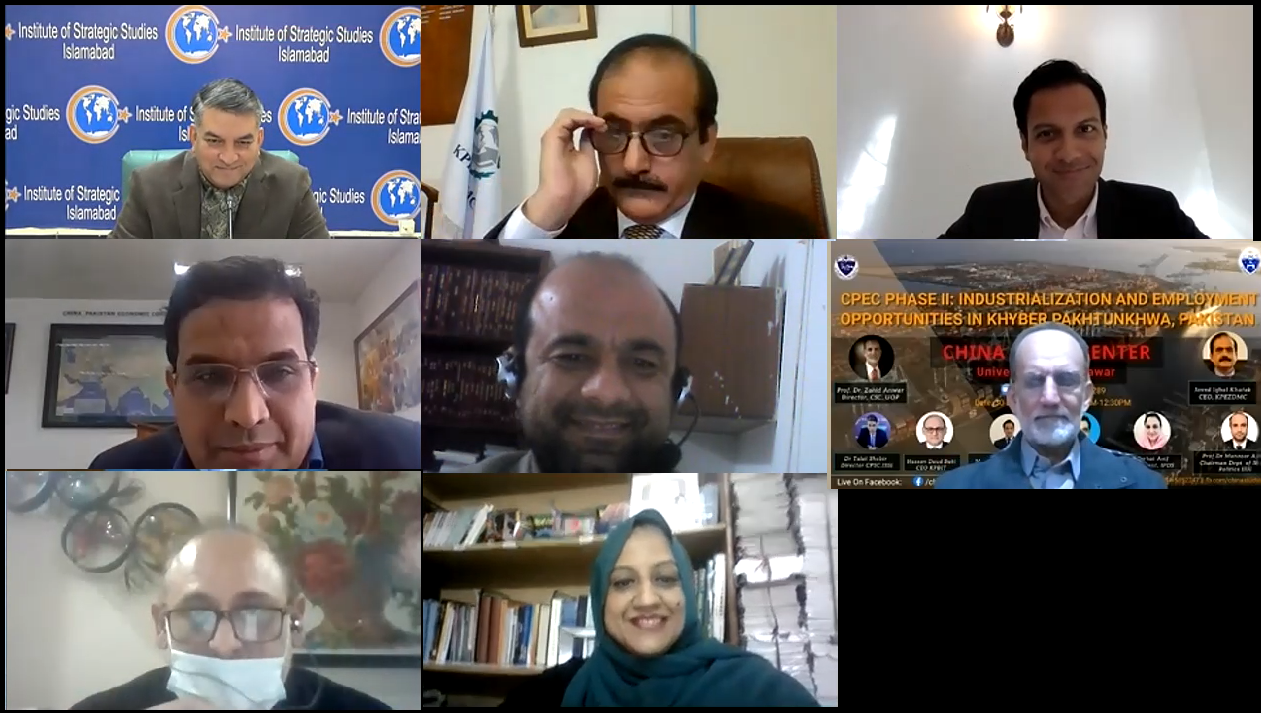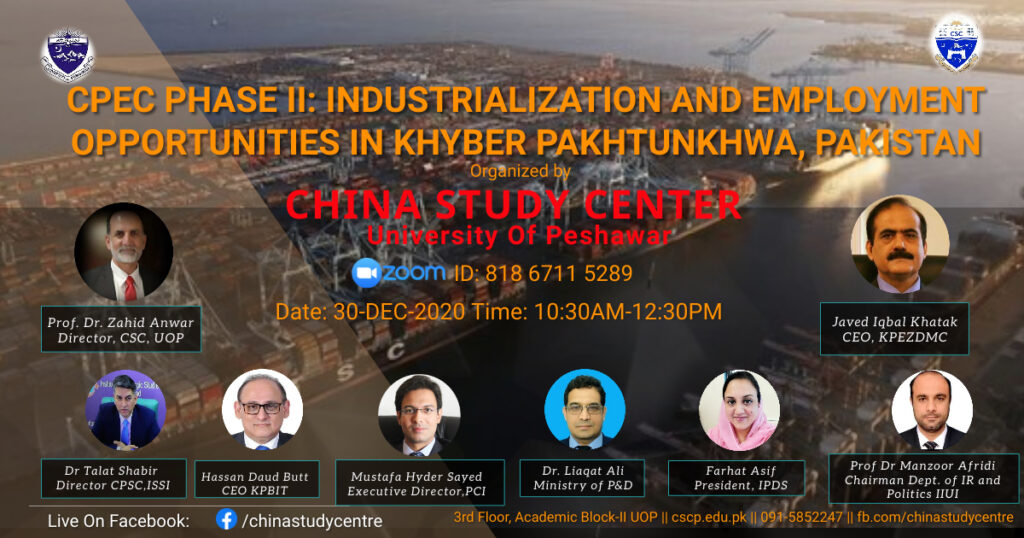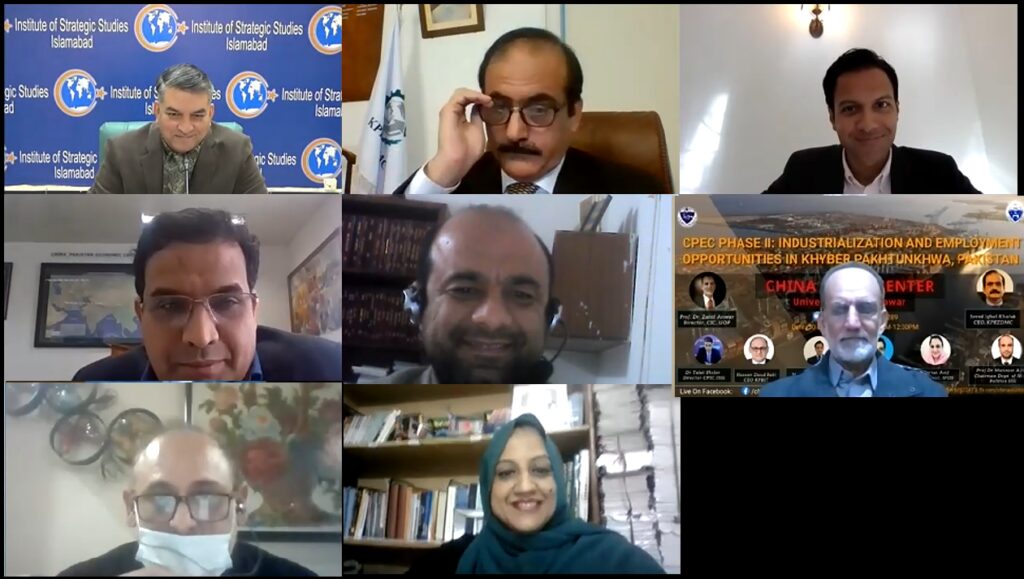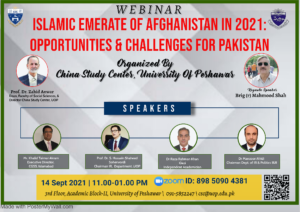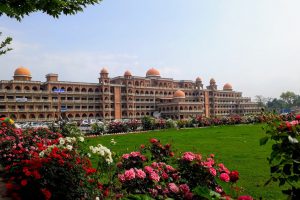China Study Center, University of Peshawar has organized a Webinar titled ‘CPEC Phase II: Industrialization and Employment Opportunities in Khyber Pakhtunkhwa, Pakistan` on 30th December 2020. Prof Dr Zahid Anwar Director China Study Center University of Peshawar in his welcome address said that China launched Belt and Road Initiative (BRI) in 2013which is a Mammoth project of regional economic connectivity and prosperity. BRI is 21st century Silk Road. Belt and Road Initiative has six economic corridors, one among those important economic corridors is called China Pakistan Economic Corridor (CPEC). CPEC is a collection of Pakistan and China joint projects in the sectors of energy, infrastructure and telecommunications. CPEC was started in 2015 and will complete in 2030. 32 early harvest projects of CPEC have been completed. Over 85000 Pakistani have got employment in CPEC projects. More than 28000 Pakistani students are now studying in China. In 2020 the second phase of China Pakistan Economic Corridor has started. The second phase of CPEC will be focused on industrialization. It will galvanize economic and employment opportunities in Pakistan. Though COVID has devastated global economy nevertheless the resilient humanity will bounce back. Today distinguished scholars will analyze the measures adopted for completion of CPEC projects in phase II during the COVID in the webinar entitled, ” CPEC PHASE II: Industrialization and Employment Opportunities in Khyber Pakhtunkhwa, Pakistan”. Gwadar deep port provides warm water access to Russia Central Asia, Afghanistan and China. Rashakai Special Economic zone will bring revolution in industrial development in Khyber Pakhtunkhwa, Khattar, and Mohmand marble city and Peshawar to Kabul motorway will enhance regional integration and economic development.
Hasan Daud Butt, CEO, KPBIT in his presentation said that the CPEC has entered crucial second phase in which cooperation in industrial development and agriculture sector improvement is vital and it has the potential to transform Pakistan`s economy and make it a regional trade hub. The industrial cooperation which commence in 2016 has gone through various stages and today Rashakai , Faisalabad and Dhabheji Special Economic Zones (SEZs) are all set for development. In the industrial cooperation under CPEC, the national aims of having SEZs are attracting FDI, export enhancement, import substitution, employment and revenue generation. The successful attraction of investment is never the achievement of a single body; it requires the coordination of many public and private sector stakeholders including State Bank, FBR, BOI and the provincial governments’ stakeholders. Complementarity, consistency, and a good coordination between investment promotion related bodies is crucial for Pakistan to meet these challenges through the retention and attraction of the necessary incentives that creates natural pull to attract investment. We need to promote a true narrative and have a marketing strategy through higher level of coordinated effort; a well-crafted support and assistance plan are correlated with increase in investment that can also ensure timely provision of utilities and other services. The attraction, set-up, and operation of investments require coordination of public and private stakeholders covering various economic sectors and many areas of government involvement. Therefore, incentives being offered need to be (a) Efficient (b)Performance-based and subject to evaluation (c) Harmonized with national investment policies (d) Non-discriminatory (e) Regionally Competitive. A comprehensive comparative analysis of competitors with a friendly long term investment strategy need to be made and led by federal BOI for a win win outcome.
Sayed Mustafa Hayder, Executive Director, Pakistan China Institute said that materializing special economic zone should be a provincial led effort, after 18th amendment the provinces are fully empowered. When foreign companies come for investment they are not clear where to go so better coordination is required and One Window Operation facility should be provided to those who want to invest. China is relocating its industries. We should identify those industries. SEZs will develop with private investment. The private investees in China have much capital to invest and they have soft corner for Pakistan. Pakistan should attract those investors. Rashakai Special Economic Zone is the top most priority of CPEC; it’s an honour that Khyber Pakhtunkhwa has CPEC projects like RSEZ. China Road and Bridge Cooperation is doing great work in RSEZ however the ownership and role should remain with KP Government. The initiative of attracting investment should remain with KP Government, KPEZDMC and KPBIT.
Dr. Talat Shabbir, Director China-Pakistan Study Centre at Institute of Strategic Studies Islamabad in his speech emphasized the need of ensuring employment opportunities in the province and learning from Chinese experience. He suggested that efforts must be made to encourage private sector investment in the Special Economic Zones (SEZs) while regulatory procedures should also be streamlined. He added that the development work of the SEZs must follow a timeline to ensure greater confidence in the progress of CPEC. Speaking on the role of think-tanks, Dr. Talat said that collaboration and data sharing should be enhanced to build our narrative and counter the propaganda against CPEC. Lastly, he said that think-tanks should aggressively follow-up their activities and bring new ideas and suggestions into practice.
Javed Iqbal Khattak CEO, KPEZDMC said that as CPEC is a flagship project of Belt and Road Initiative so is Rashakai Special Economic Zone (RSEZ) a flagship project of CPEC Special Economic Zones. RSEZ is spread over one thousand acres areas. All the basic and preliminary infrastructure work has been completed in coordination with Chinese government. The prime minister has given his approval. China`s CRBC has started working on provision of basic infrastructure inside of the zone. Access road and provision of utilities have been provided. One Chinese steel firm has started work inside the economic zone. We have received 1700 applications from different investors which is a very encouraging development for us. RSEZ will boost economic recovery and exports of this region. Khattar is open for all investors domestic and foreign. Some Chinese companies have invested in Gadoon Amzai Industrial Area in Swabi and in Khattar. RSEZ is a top priority project of the Government of Pakistan. We are closely working with Chinese government and Chinese enterprises. We are also working to develop Mohmand Special Economic Zone and establishing a Center of Excellence for mining and processing technologies there. In Phase ii we are offering 3000 acres area in Daraban Economic Zone near D I Khan on zhob-Quetta Road and Chinese companies are taking keen interest in investment there. We are opening Jaluzai, Nowshehra, Ghazi, Chitral for investment. From RSEZ 2 to 3 lacs people in the province will get employment.
Dr Liaqat Ali Shah from Ministry of Planning in his speech said that economic transformation is taking place in China. China will relocate some its industries like cement, steel etc. We are marketing our SEZs. We should target some industries and companies in China regarding the relocation. Pakistan can get benefit from this transformation. We have identified 52 products where we are globally competitive. We need to go with a marketing strategy. Conducive environment is more important than incentive for the success of business. For the success of CPEC projects regulations reforms are necessary and the procedural hurdles should be tackled properly. KP has now a new industrial policy which is a good development. We need a sound regulatory framework. We have started working on it. We have a project called PRMI (Pakistan Regulatory Modernization Initiative) led by Commerce Ministry and Board of Investment. We should ponder whether to increase the number of SEZs or focus on the quality.
Ms Farhat Asif , President IPDS in her presentation said that we should focus more on materializing the existing SEZs.138 countries have joined BRI. BRI and CPEC are connecting Pakistan to GVC (Global value Chain). We need political stability to develop our economy. We need science and technology for developing domestic industrial capacity and should transform the challenge of COVID-19 pandemic into an opportunity. CPEC is an opportunity and we should teach different skills to our young peoples, skills that are required in these CPEC projects.
Dr Manzoor Afridi, head of Politics and IR, IIUI said that SEZs played pivotal role in the economic development of China. Pakistan has 9 SEZs under CPEC which are established to follow the Chinese successful experience. KP can provide good environment to Chinese investors. He said that according to Chief Minister Mahmood Khan, RSEZ will provide 2 lac jobs. Coordination among different ministries is necessary and we can connect RSEZ to Afghanistan and Central Asia. Hopefully Doha Accord will bring peace to Afghanistan. KP province of Pakistan has strategic and economic importance. Initially China Pakistan relations were more focused on defense ties but after CPEC the economic component also got due attention. People to people contact need to be further enhanced. Chinese people have very good perception of Pakistan. CPEC will economically develop Pakistan and KP without an iota of doubt he added. The panelists’ speeches were followed by question answer and a large number of experts, scholars, students, faculty and journalist have participated in this enriching interaction
By
Prof Dr Zahid Anwar
Director,
China Study Center
University of Peshawar, PAKISTAN
Wechat:hizahid, 03339183724, csc@uop.edu.pk

